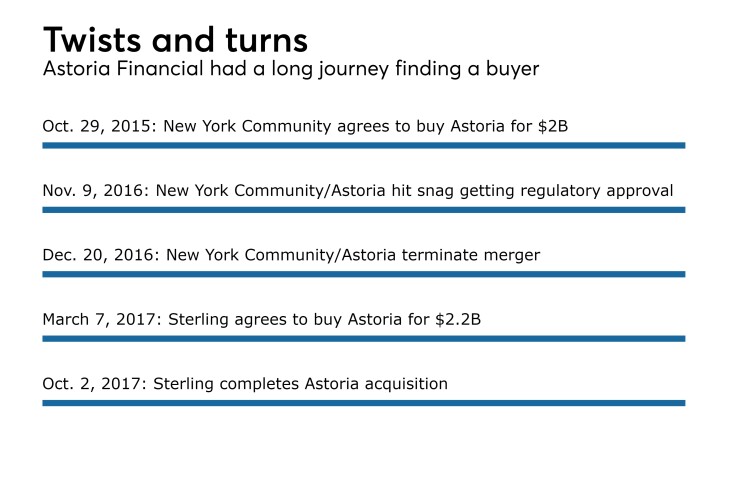Very little about the sale of Astoria Financial has been easy.
It took the company two years, two merger partners and one aborted deal before its purchase by Sterling Bancorp in Montebello, N.Y.
Now Sterling must master a more difficult challenge — convincing investors that it can make the most of the $2.2 billion acquisition by turning Astoria's mortgage-centric loan portfolio into one that can generate plenty of commercial credits.
The $31 billion-asset Sterling nearly doubled its size when it closed the deal, which also brought in sticky, low-cost deposits and a large presence on Long Island. But it will also test the company’s ability to turn Astoria’s mortgage-heavy loan book into one that is more reflective of a commercial bank.

To be sure, Sterling has traveled this road before as it reinvented itself after the financial crisis. Still, any softening in loan demand or deterioration in credit quality could throw management a curve ball.
The potential for execution risk seems embedded in Sterling’s stock price, which lags those of banks with similar size and performance profiles and remains 6% below where it stood the day before the Astoria deal was announced. Cautious investors want to see if management can deliver on a promise to make more loans, industry observers said.
“There isn’t perfect clarity" regarding Sterling's plan to originate more loans, said Joseph Fenech, an analyst at Hovde Group. "To me, there’s a trust factor here if you like the management team and you understand the impetus for the deal.”
Astoria originally agreed in late 2015
“New York Community would have crossed the $50 billion threshold, which is where new key regulations kick in,” said Erik Zwick, an analyst at Stephens. “They had some challenges of their own such as high CRE concentrations and low liquidity levels. … Sterling had a clear plan for remixing the balance sheet and fixing the financial challenges they had.”
Jack Kopnisky, Sterling’s president and CEO, has a history of transforming sizable balance sheets. He led the $3.8 billion-asset Provident New York Bancorp as it diversified its portfolio, culminating in
Sterling also lowered its efficiency ratio from roughly 62% in early 2014 to 51% at the end of the third quarter.
More than half of Astoria’s total loans at June 30 were residential mortgages, and it had less than $100 million in commercial-and-industrial loans on its balance sheet.
Such success gives Kopnisky and his team credibility as they look to reinvent Astoria, where more than half of total loans at June 30 were residential mortgages.
“This is not [Kopnisky’s] first rodeo,” Fenech said. “He’s just very effective. He has had a vision for the company. He has done what he said he would do.”

Commercial-and-industrial loans made up just 11% of Provident’s overall portfolio in mid-2012. At Sept. 30, nearly half of the total loans were commercial credits.
Sterling did not comment for this story.
A key component to adjusting Astoria’s balance sheet will involve focusing more on commercial lending. Management hasn’t specified if they will do that through loan sales or by allowing credits to run off, industry experts said.
“The challenge of replacing [Astoria’s mortgage] loan portfolio is a real one,” said Alexander Twerdahl, an analyst at Sandler O’Neill.
Management wants to generate 8% to 10% loan growth annually from the combined company. It seems that investors are skeptical that Sterling will be able to hit those targets and successfully retool Astoria’s loan book.
“A key component of the success of this deal is executing on the loan growth and remixing the” Astoria portfolio, Zwick said. “That requires a material increase in loan originations. The market has taken a show-me approach and are waiting to see the results. Until those results materialize, I’d expect that discount to remain but slowly to close over time.”
Sterling has already hired 35 commercial bankers, relationship managers and business development officers across various business lines in the last six months, Kopnisky said during a recent conference call to discuss third-quarter results. Kopnisky said he expects to see a “significant ramp-up in loan and deposit production” next year.
The company is also looking to buy loan books to bolster growth. Kopnisky said during the call that they “see portfolios all the time, like we're looking at several right now” which cover a spectrum of loan categories.
“We've been pretty disciplined about frankly saying [that a deal will] hit our targets of return and risk — or we pass on them,” Kopnisky added. “We've obviously passed on a lot of them. But there are continuous opportunities to look at purchasing portfolios.”
Hitting loan growth targets could become difficult if demand softens and banks pull back in areas like commercial real estate. Still, geography should help Sterling as it looks to expand.
“Loan demand nationally is less than what we would hope for at this point in the cycle, but given their market the opportunity presents itself,” Twerdahl said. “Keep in mind they’re in metro New York, so there’s enormous loan demand.”
Kopnisky has been optimistic about Sterling’s ability to hit its targets due to the recent hires, a diverse legacy loan portfolio and a growing operation around New York.
“We think because of the team productivity, the opportunity in the market, a big diverse market and the mix of businesses we have [that] we have a great opportunity to achieve those numbers,” Kopnisky said when asked during the call about his growth projections.
While it is unlikely that Sterling will complete another bank acquisition in the next 18 to 24 months, industry experts said they expect Kopnisky to pursue more deals over time.
“I don’t think it’s over,” Twerdahl said. “You’re looking at least a two-year pause to make sure Astoria is integrated, but it's by no means the end of the road.”





